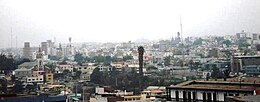Arequipa
| Arequipa | |||||||
|---|---|---|---|---|---|---|---|
| Region capital | |||||||
| City of Arequipa | |||||||
From top: Cathedral; Downtown scenery (left); Quimera City Center; Santa Catalina Monastery; partial view of the city
|
|||||||
|
|||||||
| Nickname(s): La Ciudad Blanca (The White City) | |||||||
| Location in Peru | |||||||
| Coordinates: 16°23′S 71°32′W / 16.383°S 71.533°WCoordinates: 16°23′S 71°32′W / 16.383°S 71.533°W | |||||||
| Country | Peru | ||||||
| Region | Arequipa | ||||||
| Province | Arequipa | ||||||
| Established | August 15, 1540 | ||||||
| Founded by | Garcí Manuel de Carbajal | ||||||
| Government | |||||||
| • Mayor | Alfredo Zegarra Tejada | ||||||
| Area | |||||||
| • Region capital | 69 km2 (27 sq mi) | ||||||
| • Metro | 2,923.53 km2 (1,128.78 sq mi) | ||||||
| Elevation | 2,335 m (7,661 ft) | ||||||
| Population | |||||||
| • Estimate (2015) | 869,351 | ||||||
| • Metro | 920.047 | ||||||
| Demonym(s) | Arequipeño | ||||||
| Time zone | PET (UTC-5) | ||||||
| • Summer (DST) | PET (UTC−5) | ||||||
| Postal code | 04000 | ||||||
| Area code(s) | 54 | ||||||
| Website | www |
||||||
Arequipa (Spanish pronunciation: [aɾeˈkipa]; Quechua: Ariqipa) is the capital and largest city of the Arequipa Region and the seat of the Constitutional Court of Peru. It is Peru's second most populous city with 861,145 inhabitants, as well as its second most populous metropolitan area as of 2016, according to the National Institute of Statistics and Informatics (INEI)
Arequipa is the second most industrialized and commercialized city in Peru. Its industrial activity includes manufactured goods and camelid wool products for export. The city has close trade ties with Chile, Bolivia and Brazil.
The city was founded on August 15, 1540, by Garcí Manuel de Carbajal as "Villa Hermosa de Nuestra Señora de la Asunción". During the Colonial period, Arequipa became highly important for its economic prosperity and for its loyalty to the Spanish Crown.
After Peru gained its independence from Spain in 1821, Arequipa acquired greater political significance, and was declared the capital city of Peru from 1835 to 1883.
The historic center of Arequipa spans an area of 332 hectares and is a UNESCO World Heritage Site. Its historic heritage, natural scenery and cultural sites make the city a major tourist destination. Its religious, colonial, and republican architectural styles blend European and native characteristics into a unique style called "Escuela Arequipeña".
A local tradition states that Inca Mayta Capac received a petition from his subjects to reach the valley of the River Chili. They asked him for permission to stay in the region as they were impressed by the beauty of the landscape and the mild climate. The Inca answered "Ari qhipay" (Quechua: "Yes, stay"). However, another similar tale states that when the first Europeans arrived to the valley, they pointed at the ground and asked for the name of the land. the local chief, not understanding the question, assumed they were asking for a permission to sit down and gave a positive answer, which sounded like "Arequipa".
...
Wikipedia








